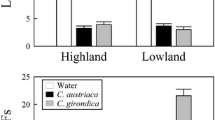Abstract
In this study we conditioned fathead minnows (Pimephales promelas) to recognize the odor of a perch (Perca flavescens) by exposing them to perch odor coupled with minnow alarm cue. We then staged encounters between the predator and prey in order to assess whether the predator odor training had any effect on survival of the prey. We tested for a survival effect in the presence and absence of shelter. Our results indicate that fish trained with alarm signals to recognize predators gained a survival benefit during staged encounters with a predator and that habitat characteristics influenced the survival of conditioned fish.
Similar content being viewed by others
REFERENCES
Berejikian, B. A., Smith, R. J. F., Tezak, E. P., Schroder, S. L., and Knudsen, D.M. 1999. Chemical alarm signals and complex hatchery rearing habitats affect antipredator behavior and survival of chinook salmon (Oncorhynchus tshawytscha) juveniles. Can. J. Fish Aquat. Sci. 56:830–838.
Chivers, D. P. and Mirza, R. S. 2001. Predator diet cues and the assessment of predation risk by aquatic vertebrates: A review and prospectus, pp. 277–284, in A. Marchlewska-Koj, J. J. Lepri, and D. Müller-Schwarze (eds.). Chemical Signals in Vertebrates, Volume 9. Plenum Press, New York.
Chivers, D. P. and Smith, R. J. F. 1994a. The role of experience and chemical alarm signaling in predator recognition by fathead minnows, Pimephales promelas. J. Fish Biol. 44:273–285.
Chivers, D. P. and Smith, R. J. F. 1994b. Fathead minnows, Pimephales promelas, acquire predator recognition when alarm substance is associated with the sight of unfamiliar fish. Anim. Behav. 48:597–605.
Chivers, D. P. and Smith, R. J. F. 1995a. Fathead minnows (Pimephales promelas) learn to recognize chemical stimuli from high-risk habitats by the presence of alarm substance. Behav. Ecol. 6: 155–158.
Chivers, D. P. and Smith, R. J. F. 1995b. Chemical recognition of risky habitats is culturally transmitted among fathead minnows, Pimephales promelas (Osteichthyes, Cyprinidae). Ethology 99:286–296.
Chivers, D. P. and Smith, R. J. F. 1998. Chemical alarm signaling in aquatic predator-prey systems: A review and prospectus. Ecoscience 5:338–352.
Chivers, D. P., Brown, G. E., and Smith, R. J. F. 1995. Acquired recognition of chemical stimuli from pike, Esox lucius, by brook sticklebacks, Culaea inconstans (Osteichthyes, Gasterosteidae). Ethology 99:234–242.
GÖz, H. 1941. Über den Art-und Individualgeruch bei Fischen. Z. Vergl. Physiol. 29:723–730.
Keppel, G. 1982. Design & Analysis: A Researchers Handbook. Prentice-Hall, Englewood Cliffs, New Jersey.
Magurran, A. E. 1989. Acquired recognition of predator odour in the European minnow (Phoxinus phoxinus). Ethology 82:216–233.
Mirza, R. S. and Chivers, D. P. 2000. Predator-recognition training enhances survival of brook trout: Evidence from laboratory and field enclosure studies. Can. J. Zool. 78:2198–2208.
Mirza, R. S. and Chivers, D. P. 2001. Do chemical alarm signals enhance survival of aquatic vertebrates? An analysis of the current research paradigm, pp. 19–26, in A. Marchlewska-Koj, J. J. Lepri, and D. Müller-Schwarze (eds.). Chemical Signals in Vertebrates, Volume 9. Plenum Press, New York.
Rochette, R., Arsenault, D. J., Justome, B., and Himmelman, J. H. 1998. Chemically-mediated predator-recognition learning in a marine gastropod. Ecoscience 5:353–360.
Siegel, S. and Castellan, N. J. 1988. Nonparametric Statistics for the Behavioral Sciences, 2nd ed. McGraw-Hill, New York, 399 pp.
Smith, R. J. F., 1992. Alarm signals in fishes. Rev. Fish Biol. Fish 2:33–63.
Suboski, M. D., 1990. Releaser-induced recognition learning. Psychol. Rev. 97:271–284.
Wisenden, B. D., CHIVERS, D. P., and SMITH, R. J. F. 1997. Learned recognition of predation risk by Enallagma damselfly larvae (Odonata, Zygoptera) on the basis of chemical cues. J. Chem. Ecol. 23:137–151.
Yunker, W. K., Wein, D. E., and Wisenden, B. D. 1999. Conditioned alarm behavior in fathead minnows (Pimephales promelas) resulting from association of chemical alarm pheromone with a nonbiological visual stimulus. J. Chem. Ecol. 25:2677–2686.
Author information
Authors and Affiliations
Corresponding author
Rights and permissions
About this article
Cite this article
Gazdewich, K.J., Chivers, D.P. Acquired Predator Recognition by Fathead Minnows: Influence of Habitat Characteristics on Survival. J Chem Ecol 28, 439–445 (2002). https://doi.org/10.1023/A:1017902712355
Issue Date:
DOI: https://doi.org/10.1023/A:1017902712355




